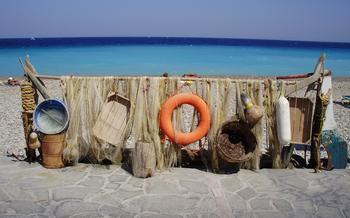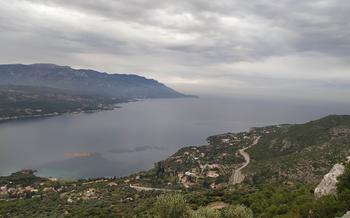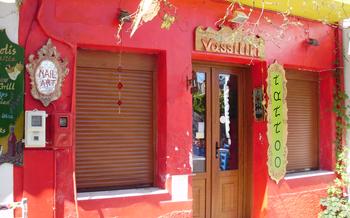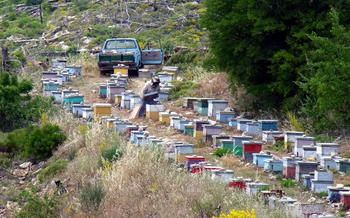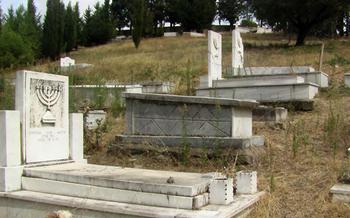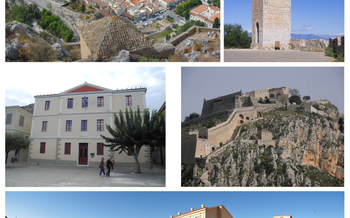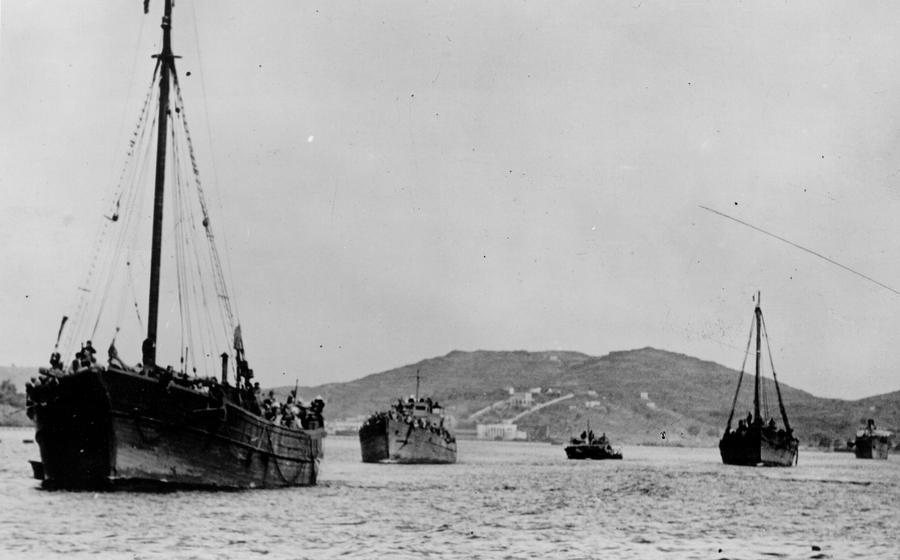
Moni Panagias Koumarianis
- Moni Panagias Koumarianis: A Sacred Haven
- A Journey Through Time: The Monastery's History
- Architectural Masterpiece: Exploring the Monastery's Design
- A Haven for Faith: The Monastery's Religious Significance
- Cultural Tapestry: The Monastery's Impact on Local Culture
- Planning Your Visit: Essential Information
- A Walk Through History: Exploring the Monastery Grounds
- Unveiling the Monastery's Treasures: Artifacts and Relics
- The Role of the Monks: Guardians of Faith and Tradition
- Immersive Experience: Attending a Divine Liturgy
- Local Delights: Savoring Samos' Culinary Treasures
- Exploring Beyond the Monastery: Samos' Hidden Gems
- Capturing the Essence: Photography Tips for Visitors
- Souvenirs and Mementos: Preserving Your Memories
- Insider Tip: Unveiling the Secret Chapel
Moni Panagias Koumarianis: A Sacred Haven
Nestled amidst the serene landscapes of Samos, Greece, the Moni Panagias Koumarianis stands as a testament to the enduring power of faith. This sacred haven, dedicated to the Virgin Mary, holds a significant place in the religious and cultural heritage of the island. Its history is deeply intertwined with the local community, and its architectural beauty reflects the rich Byzantine and post-Byzantine influences that shaped the region. As visitors step through the gates of this holy sanctuary, they embark on a journey through time, discovering the profound spiritual and cultural significance it embodies.
-
History and Significance: The Moni Panagias Koumarianis was founded in the 16th century by a group of devout monks seeking a secluded place to worship and devote themselves to their faith. Over the centuries, the monastery has become a spiritual beacon for the people of Samos, attracting pilgrims and visitors from near and far. It has played a crucial role in preserving and promoting Orthodox Christian traditions, serving as a center for religious education and spiritual guidance.
-
Architectural Features: The monastery's architectural design showcases a harmonious blend of Byzantine and post-Byzantine influences. Its whitewashed walls, arched doorways, and intricate carvings create a captivating visual spectacle. The church, the heart of the monastery, features stunning frescoes and iconography depicting biblical scenes and stories. The bell tower, with its distinctive silhouette, stands tall as a symbol of the monastery's enduring presence.
-
Religious and Cultural Importance: The Moni Panagias Koumarianis holds immense religious and cultural significance for the local community. It is a place where people come together to pray, seek solace, and celebrate their faith. The monastery also plays an integral role in preserving and promoting local traditions and customs. It hosts various religious festivals and events throughout the year, attracting visitors from all over the island.
A Journey Through Time: The Monastery's History
The founding of Moni Panagias Koumarianis dates back to the 16th century, during a period marked by the Ottoman occupation of Greece. According to legend, a group of devout monks sought refuge in the mountainous region of Samos, seeking a secluded haven where they could freely practice their faith. They discovered a hidden valley and established the monastery in 1565, dedicating it to the Virgin Mary.
Over the centuries, the monastery faced various challenges and periods of significance. During the Greek War of Independence in the 19th century, it served as a refuge for local fighters and a sanctuary for those seeking protection from Ottoman forces. The monastery also played a pivotal role in preserving religious traditions and providing spiritual guidance to the local community throughout its history.
Architectural Masterpiece: Exploring the Monastery's Design
The Moni Panagias Koumarianis stands as a testament to the architectural prowess of its builders, seamlessly blending Byzantine and post-Byzantine influences to create a harmonious and awe-inspiring structure. The church, the heart of the monastery, is a magnificent edifice adorned with intricate frescoes and iconography that narrate biblical stories and the lives of saints. Its iconic dome, a symbol of divine presence, dominates the skyline and serves as a beacon of faith for the surrounding community.
The bell tower, a majestic structure that rises from the monastery's courtyard, echoes with the melodious chimes that mark the passage of time and call the faithful to prayer. Its intricate carvings and decorative elements showcase the meticulous craftsmanship of the builders, transforming the tower into a work of art that complements the overall architectural ensemble.
The monastery's courtyard, a tranquil oasis amidst the bustling surroundings, provides a serene space for contemplation and reflection. Surrounded by elegant arches and columns, the courtyard features a central fountain that adds a touch of tranquility to the atmosphere. The use of traditional building materials, such as stone and wood, lends an air of authenticity and rustic charm to the monastery's design.
A Haven for Faith: The Monastery's Religious Significance
Moni Panagias Koumarianis stands as a testament to the deep Orthodox Christian faith that permeates the hearts of the local community. As a center of Orthodox Christianity, the monastery has played a pivotal role in preserving and promoting religious traditions for centuries. The sacred grounds are often adorned with intricate iconography and adorned with beautiful frescoes, which depict scenes from the Bible and the lives of the saints. These awe-inspiring works of art serve as a visual reminder of the rich spiritual heritage that is deeply embedded within the monastery's walls.
Devout visitors from near and far flock to this sacred site to seek spiritual guidance and enlightenment. The monastery's monks, who have devoted their lives to serving God, are renowned for their wisdom and compassion. They offer spiritual counseling, lead prayer services, and provide a comforting presence to those seeking solace and guidance. The monastery also plays a crucial role in organizing religious festivals and celebrations, which bring the local community together in a spirit of unity and devotion.
For those seeking a deeper connection with their faith, Moni Panagias Koumarianis offers a serene and conducive environment for spiritual reflection and prayer. The monastery's tranquil ambiance and the presence of sacred relics create a palpable sense of holiness, making it an ideal destination for pilgrims seeking spiritual renewal and rejuvenation.
Cultural Tapestry: The Monastery's Impact on Local Culture
Moni Panagias Koumarianis is not just a religious landmark; it is an integral part of the cultural fabric of Samos. Over the centuries, the monastery has woven itself into the lives of the local community, leaving an indelible mark on their traditions, festivals, and customs.
The monks have played a pivotal role in preserving and promoting the island's cultural heritage. They have organized and participated in local festivals, such as the annual Panagia Koumarianis Festival, which attracts visitors from all over the region. During these celebrations, the monastery becomes a vibrant hub of activity, filled with music, dance, and traditional food.
Beyond religious events, the monastery has also been a driving force behind the preservation of traditional customs and crafts. The monks have supported local artisans and craftsmen, encouraging them to continue their traditional practices. As a result, visitors to Samos can still experience the island's rich cultural heritage through its handmade ceramics, textiles, and other artisanal products.
The monastery's presence has also influenced the local cuisine. The monks have cultivated their own vineyards and olive groves, producing high-quality wine and olive oil. These products are not only enjoyed by the monks themselves but are also shared with the local community and visitors alike, showcasing the unique flavors and culinary traditions of Samos.
Planning Your Visit: Essential Information
Before embarking on your pilgrimage to Moni Panagias Koumarianis, it is essential to plan your visit carefully. The monastery is conveniently located on the island of Samos, with easy accessibility by road. Once you arrive, the gates of the monastery are open to visitors from 8:00 AM to 12:00 PM and again from 4:00 PM to 7:00 PM daily. To fully appreciate the monastery's sanctity, a nominal admission fee is requested.
As you approach the monastery, remember that you are entering a sacred space. Please dress respectfully, covering your shoulders and knees. Upon entering the monastery grounds, silence and contemplation are encouraged to maintain the serene atmosphere.
A Walk Through History: Exploring the Monastery Grounds
As you step through the entrance of Moni Panagias Koumarianis, a sense of awe washes over you. The monastery's layout is a testament to its rich history, with each corner revealing a new story. The main church, a masterpiece of Byzantine architecture, dominates the central courtyard. Its intricate frescoes and iconography depict scenes from the Bible and the lives of saints, inviting you on a journey through time.
Beyond the church, the courtyard gardens offer a tranquil oasis. Olive trees, fragrant flowers, and murmuring fountains create a serene atmosphere, inviting you to pause and reflect. Take a moment to stroll through the gardens, admiring the beauty of nature and the monastery's harmonious blend of architecture and landscape.
Unveiling the Monastery's Treasures: Artifacts and Relics
Moni Panagias Koumarianis houses a collection of precious religious artifacts, icons, and manuscripts that tell the story of its rich history and spiritual significance. Among the notable treasures are exquisitely crafted icons depicting saints and scenes from the Bible, some dating back several centuries. These icons are not merely decorative pieces but are revered objects of devotion, believed to possess miraculous powers and serve as a tangible connection to the divine.
The monastery also houses a collection of ancient manuscripts, including handwritten Bibles, liturgical texts, and historical records. These manuscripts provide a glimpse into the monastery's past, shedding light on its founding, the lives of its monks, and the role it played in the religious and cultural life of the region.
Stories and legends have been passed down through generations, adding to the mystique of these treasures. One such tale speaks of a hidden icon of the Virgin Mary, said to have miraculous healing properties. Devout pilgrims often seek out this icon, believing in its power to bring solace and healing to those in need.
Visitors to the monastery are granted the privilege of viewing these treasures, which are carefully preserved and displayed within the church and other designated areas. The monks take great pride in sharing their sacred heritage with visitors, offering insights into the significance and symbolism of each artifact.
The Role of the Monks: Guardians of Faith and Tradition
In the serene monks upholds the traditions of Orthodox monasticism. Their daily lives revolve around prayer, contemplation, and service, embodying the essence of the monastic calling. Visitors to the monastery are granted a glimpse into their sacred routine, witnessing the devotion and commitment that define their existence.
The monks adhere to a strict schedule of daily prayers, rising before dawn to chant the morning liturgy and continuing throughout the day with various services. Their prayers resonate through the monastery's hallowed halls, creating a palpable atmosphere of spirituality. Beyond their religious duties, the monks engage in a variety of tasks that contribute to the upkeep and functioning of the monastery. They cultivate the surrounding gardens, care for the animals, and attend to the needs of pilgrims and visitors.
The role of the monks extends beyond the monastery walls, as they actively engage with the local community. They offer spiritual guidance, participate in religious ceremonies, and provide support to those in need. Their presence is a source of comfort and inspiration for the faithful, reinforcing the monastery's role as a spiritual beacon in the region.
Interacting with the monks is a unique opportunity for visitors to gain insights into the essence of monasticism and the profound impact it has on the local culture. Their stories, wisdom, and dedication serve as a reminder of the enduring power of faith and the importance of preserving religious traditions.
Immersive Experience: Attending a Divine Liturgy
For a truly immersive experience, visitors to Moni Panagias Koumarianis have the opportunity to attend a divine liturgy, the central act of worship in the Orthodox Christian tradition. This sacred ceremony, typically held in the early morning, offers a glimpse into the deep faith and spirituality that permeates the monastery.
The liturgy is led by the monastery's monks, who chant prayers and hymns in a beautiful harmony of voices. The service includes the reading of Scripture, the offering of prayers, and the sacrament of Holy Communion. Visitors are welcome to participate in the liturgy, following along with the prayers and responses in the provided booklets.
Attending a divine liturgy at Moni Panagias Koumarianis is a unique opportunity to witness the vibrant and living tradition of Orthodox Christianity. It is an experience that will leave a lasting impression on visitors, deepening their understanding of the monastery's spiritual significance and the faith that guides the lives of its monks.
Here are some tips for respectful participation in a divine liturgy:
- Dress modestly and avoid wearing shorts, tank tops, or revealing clothing.
- Be mindful of your behavior and maintain a reverent attitude throughout the service.
- If you are not familiar with the Orthodox liturgy, follow along with the provided booklets or ask a fellow attendee for guidance.
- Photography and recording are typically not allowed during the liturgy, so be sure to respect the monastery's guidelines.
Local Delights: Savoring Samos' Culinary Treasures
A visit to the Moni Panagias Koumarianis is not complete without indulging in the culinary delights of Samos. The island is renowned for its rich gastronomic heritage, offering a tantalizing array of traditional Greek dishes and local specialties.
In the vicinity of the monastery, visitors can find a selection of charming restaurants and tavernas that showcase the true essence of Greek cuisine. These establishments serve up mouthwatering dishes prepared with fresh, locally sourced ingredients, ensuring an authentic culinary experience.
When in Samos, be sure to savor the island's signature dishes, such as "Samos Saganaki," a delectable dish featuring sautéed shrimp in a rich tomato sauce, and "Moussaka," a traditional casserole made with layers of eggplant, potatoes, minced meat, and a creamy béchamel sauce.
For a taste of the sea, try the grilled octopus or the "Gavros," small fried anchovies that are a local delicacy. Vegetarians will delight in the variety of fresh salads, stuffed vegetables, and "gemista," a dish of tomatoes and peppers stuffed with rice, herbs, and spices.
Pair your meal with a glass of Samos' renowned sweet Muscat wine, produced from the island's sun-kissed grapes. This golden nectar is a perfect accompaniment to the local cuisine and adds a touch of sweetness to your dining experience.
Exploring Beyond the Monastery: Samos' Hidden Gems
While the Moni Panagias Koumarianis stands as a primary attraction, Samos offers a wealth of additional treasures waiting to be discovered. Venture beyond the monastery's walls to uncover hidden gems that showcase the island's rich history, natural beauty, and cultural heritage. Explore the picturesque villages nestled amidst rolling hills, each with its unique charm and traditions. Embark on invigorating hikes through lush forests, leading to breathtaking views and secluded beaches. Discover ancient ruins and archaeological sites that tell tales of Samos' past civilizations. Indulge in culinary delights at local tavernas, savoring fresh seafood and traditional Greek dishes. Whether seeking adventure, relaxation, or cultural immersion, Samos offers an array of experiences to captivate every traveler.
Capturing the Essence: Photography Tips for Visitors
The Moni Panagias Koumarianis, with its stunning architecture, natural beauty, and sacred atmosphere, offers a wealth of photographic opportunities. To capture the essence of this unique monastery, consider the following tips:
-
Timing is Key: The early morning and late afternoon light provides the most flattering illumination for photography. Aim to visit during these times to capture the monastery's architectural details bathed in golden light.
-
Composition Matters: Experiment with different angles and perspectives to create dynamic compositions. Capture the monastery's grandeur by including the surrounding landscape or focus on specific architectural features for a more intimate shot.
-
Respect the Serenity: Remember that this is a sacred space where visitors are seeking peace and tranquility. Be mindful of your noise level and movements, and avoid using flash photography to ensure a respectful atmosphere.
-
Capture the Details: Pay attention to the intricate details that make this monastery special. From the delicate frescoes adorning the church interior to the weathered stonework of the walls, each element tells a story.
-
Embrace Black and White: Consider using black and white photography to create a timeless and emotive representation of the monastery. This technique can emphasize the monastery's architectural lines and textures, conveying a sense of history and reverence.
Souvenirs and Mementos: Preserving Your Memories
As you depart from the sacred grounds of Moni Panagias Koumarianis, you may wish to carry a piece of its spirit with you. Within the vicinity of the monastery, you'll find a selection of shops and stalls offering a variety of souvenirs and mementos to cherish your visit.
Religious artifacts, such as icons, prayer beads, and small crosses, are popular choices for those seeking a tangible reminder of their spiritual journey. These items are often handcrafted by local artisans, imbuing them with a unique charm and significance.
For those drawn to the monastery's historical and cultural heritage, handicrafts and traditional products made by local craftsmen are excellent choices. Woven baskets, embroidered textiles, and hand-painted ceramics reflect the rich artistic traditions of Samos and serve as beautiful keepsakes.
When selecting souvenirs, opt for items that are ethically sourced and support local artisans. This ensures that your purchases contribute to the preservation of traditional skills and crafts while fostering the economic well-being of the community.
Consider purchasing local delicacies, such as honey, olive oil, or traditional sweets, as edible souvenirs. These culinary treasures will delight your taste buds and transport you back to the flavors of Samos long after your visit.
Whether you choose a religious artifact, a handcrafted piece, or a local delicacy, your souvenir will serve as a tangible reminder of your pilgrimage to Moni Panagias Koumarianis, preserving the memories and emotions you experienced within its sacred walls.
Insider Tip: Unveiling the Secret Chapel
Beyond the main church, the monastery holds a hidden gem that few visitors know about—a secret chapel tucked away within its walls. This secluded sanctuary, known as the Chapel of the Holy Virgin, is a place of profound spirituality and historical significance.
Legend has it that the chapel was built in the 16th century by a monk who sought refuge from a pirate attack. Guided by divine inspiration, he discovered a hidden cave and constructed the chapel within it. The chapel remained a secret for centuries, known only to a select few.
In recent years, the chapel has been restored and opened to visitors. It is a small, intimate space with a simple altar and beautiful frescoes depicting scenes from the life of the Virgin Mary. The atmosphere is serene and contemplative, inviting visitors to connect with their spiritual side.
To access the secret chapel, visitors should inquire with the monks or the monastery staff. They will be able to provide directions and ensure that visitors adhere to the proper etiquette and respect the sacredness of the space.
